Clare Wilkinson, Andrew King, Thomas Guthrie
Participants in the recording talk about their experiences….
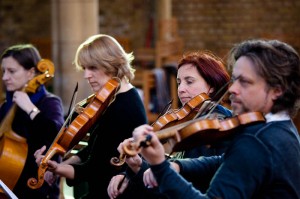 Bjarte Eike (violin)
Bjarte Eike (violin)
Since I first met Robert Hollingworth and I Fagiolini in Copenhagen some eight years ago I have had the pleasure of working with them on numerous occasions. What has always struck me is that one project never is the same as the previous one – even if it is a repeat of the same concert; there is always a completely new feeling. It has puzzled, but also inspired me. I think it is because Robert wants to keep things alive, fresh and with a sense of daring – never static. This ability or philosophy is crucial to musicians in the field of performing live music, and I bring my experiences from working with Robert and I Fagiolini while working with my own group Barokksolistene.
When Robert mentioned he was planning to record the massive Striggio – and didn’t have a place for me (even if there were about 1850 players involved – I must be very far down on the I Fag list of guest musicians, moan, moan) – I was of course slightly (!) disappointed, but also excited to see the fantastic result and its huge success. So it was with great joy (and relief) that I was invited to do this project. But then, I realised that almost half the time I was downgraded to play VIOLA!! I almost turned the whole thing down, but then decided playing viola was probably good for my ego…
It turned out to be an experience typical of Robert and I Fagiolini: exciting singers and players performing in ever-changing constellations and Robert in the middle with total control and confidence of the score and what he wants. It also occurred to me during this production that there now are a lot of English players that specialise in Renaissance and early baroque repertoire; something that has changed over the past ten years or so. So maybe it wasn’t that strange that I wasn’t invited to join the Striggio recording after all…Â [Oh stop whining – RH]
I am very excited to hear and see the result of these lovely and (as ever) inspiring sessions!
Gawain Glenton (cornett)
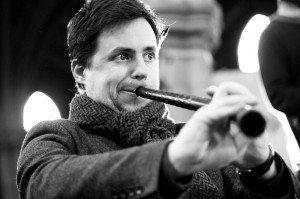 For us cornetto players this follow-up to the Striggio CD was a real treat. When playing cornetto parts written by Giovanni Gabrieli, you know that the players he was writing for were men like Girolamo Dalla Casa and Giovanni Bassano – two of the greatest cornetto players who ever lived! As for Viadana, I was familiar with his instrumental music and some of his small-scale songs, but I had never played any of his large 4-choir psalms. It’s wonderful stuff and just goes to show how much music there is out there yet to be played and discovered. Monteverdi’s 1610 Vespers is fantastic music and I’m lucky to play it so often but, as this CD shows, it really is just the tip of the iceberg.
For us cornetto players this follow-up to the Striggio CD was a real treat. When playing cornetto parts written by Giovanni Gabrieli, you know that the players he was writing for were men like Girolamo Dalla Casa and Giovanni Bassano – two of the greatest cornetto players who ever lived! As for Viadana, I was familiar with his instrumental music and some of his small-scale songs, but I had never played any of his large 4-choir psalms. It’s wonderful stuff and just goes to show how much music there is out there yet to be played and discovered. Monteverdi’s 1610 Vespers is fantastic music and I’m lucky to play it so often but, as this CD shows, it really is just the tip of the iceberg.
Gawain plays Exaudi, Deus by Barbarino
William Lyons (dulcian)
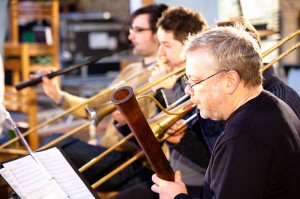 My ensemble The City Musick provided the shawms, dulcians and recorders choir for the Striggio project, and once again several members – Nick Perry, Tom Lees, Gawain Glenton and I – were involved in this recording. Playing in reconstructions of large-scale Renaissance polychoral projects is something of a treat for us Renaissance blowers. For Nick and me, brought in as players of the bass dulcian, there was an extra burnish to the occasion as we’ve suffered in the past from the curious modern convention that reed players weren’t used in Italian 16th and17th century church music. Finally that misconception is receding and dulcians are finally being restored to their rightful place alongside the subtle brilliance of the cornett and sackbut ensemble. The reed basses add an extra pungency to the flavour of the wind band, and it was interesting to note how well the dulcian works within a smaller mixed ensemble of cornett, viola and trombone as well as providing the weighty bass to the large ensemble pieces.
My ensemble The City Musick provided the shawms, dulcians and recorders choir for the Striggio project, and once again several members – Nick Perry, Tom Lees, Gawain Glenton and I – were involved in this recording. Playing in reconstructions of large-scale Renaissance polychoral projects is something of a treat for us Renaissance blowers. For Nick and me, brought in as players of the bass dulcian, there was an extra burnish to the occasion as we’ve suffered in the past from the curious modern convention that reed players weren’t used in Italian 16th and17th century church music. Finally that misconception is receding and dulcians are finally being restored to their rightful place alongside the subtle brilliance of the cornett and sackbut ensemble. The reed basses add an extra pungency to the flavour of the wind band, and it was interesting to note how well the dulcian works within a smaller mixed ensemble of cornett, viola and trombone as well as providing the weighty bass to the large ensemble pieces.
Robert is whippet-keen on ‘line’ – this music is monumental in structure but it’s the filigree that makes this music so perfect: the Angel, not the Devil, is in the detail here. I often think not of the mathematical principles that defined the design of medieval and renaissance architecture, but more of the Arcadian delights of perfection that rigorous mathematics allowed to shine forth in the great cathedrals and patrician buildings of 15th and 16th century Italy. The music for this recording is an aural reflection of those decorative intricacies matched with a solidity of structure. Having the extra colour of the reed at the bass and within the texture of the mixed consort of brass and strings defines and clarifies that ‘line’ that is so fundamental to this style of composition. In order to reinforce this I experimented with different reeds to give varied definition to the sound of the dulcian: edgy and cutting within the full ensemble pieces, softer and more rounded when playing with cornetts, voices and strings in the more intimate items.
Good to see Adrian Hunter, with whom I’ve worked with many times with his finger on the production pulse. I like the panoramic spread of sound he gets in his recordings, vital when dealing with these complex and varied sonorities.
Matthew Long (tenor)
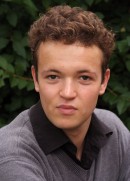 After the huge success of the Striggio disc and the great fun we had recording it (I particularly enjoy listening to the Tallis), I was excited and looking forward to tackling some similar repertoire. It is always a joy to see and work with so many friends and colleagues in the same place and at the same time.
After the huge success of the Striggio disc and the great fun we had recording it (I particularly enjoy listening to the Tallis), I was excited and looking forward to tackling some similar repertoire. It is always a joy to see and work with so many friends and colleagues in the same place and at the same time.
A particular role for me in this recording was as part of a tenor duet in the Viadana psalms. I always find singing duets from this period with other tenors a rewarding experience! I have very fond memories of hearing for the first time the solo tenor duets in Monteverdi’s Dixit Dominus setting from the 1610 Vespers. I was in my first year at the University of York at the time and the two tenors were Jason Darnell and Joshua Elicott. They made a massive impression on me with their florid interpretations of the psalm verses Iuravit Dominus and Conquassabit capita. So for me, working on the duet passages in the Viadana with Nicholas Smith for this recording was an obvious highlight. And hearing the period instruments played by the best players around is always a privilege.
The sense of fun alongside the serious work seems to be an important aspect of what Robert and I Fagiolini do and I find this to be a breath of fresh air and at the heart of good music making. I Fagiolini projects presents serious challenges and there is no room for complacency (not always the case in my experience of consort/choral singing).
I think the sound of the group is one that is built from the individual voices and not at the expense of the individual voices as can so often be the case. This is a definite plus point from my point of view and makes for a far more enjoyable singing experience.
Robert’s jokes during rehearsals help to keep the brain ticking over, so coupled with the good singing, I find working with Fag is a really holistic experience. I also seem to have enjoyed reaching new heights in the pulling of ridiculous faces and the moments where I do so in the promotional video will now never be lived down amongst family and friends.
The tea helpers
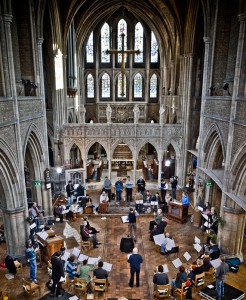 No I Fagiolini recording would ever be as successful without the combined efforts of the volunteers – members of the Friends of I Fagiolini – who come to provide refreshments, including the sensational homemade cake. Three of the helpers (who wish to remain anonymous) sent their thoughts on being present at the recording sessions. [RH note: these are no ordinary tea ladies. They are all experienced amateur singers with specific academic areas of knowledge of which I have regular need!]
No I Fagiolini recording would ever be as successful without the combined efforts of the volunteers – members of the Friends of I Fagiolini – who come to provide refreshments, including the sensational homemade cake. Three of the helpers (who wish to remain anonymous) sent their thoughts on being present at the recording sessions. [RH note: these are no ordinary tea ladies. They are all experienced amateur singers with specific academic areas of knowledge of which I have regular need!]
To start with a cliché, but one totally appropriate in this case, it was a privilege to be there. The patient professionalism of everyone concerned was amazing, as we moved through the 500+ takes. At about four o’clock on Friday, after three whole days of recording, I re-entered the church and heard a gorgeous baritone voice singing Monteverdi plain chant from behind a pillar. Eamonn [Dougan], I thought, and moved to where I could see. Yes, Eamonn it was, but together with three others and yet singing as one. Never have I heard such a flawless unison. Also on Friday, the solo cornett player [Gawain Glenton] produced a sound so sweet and rounded that I wondered if I had ever before really heard that instrument played as it should be and my eyes were opened to an area of undiscovered musical beauty. At the end of the day too, Adrian Hunter [producer] was still framing perfectly apt comments on each take, always preceded by a word of appreciation or praise. Perhaps it helped that he was working in the only really warm part of the building, but I have a feeling he would remain entirely focussed anyway, whatever the circumstances!
So did we get a sneak preview of the CD? Not really, more a series of delectable tasters to whet our appetites. It was a bit like looking in on the making of one of those magnificent Byzantine wall mosaics, but while the choice stones and metals to be used are only partly fixed into their places on the wall. From time to time we glimpsed large, recognisable chunks of the big picture, but from the back of the church we tended to miss the interchanges between Robert and Adrian, and had to consult among ourselves in hurried whispers during the non-recording moments. ‘Where have they got to?’ ‘Which bit is this?’ ‘Is this Viadana or Gabrieli?’ ‘Must be Gabrieli, I’ve heard it before.’ ‘Have you really? Are you sure?’ I look forward to the moment when, with the CD playing and the notes to hand, all will be made clear.
Other things I shall remember (by no means exhaustive):
- Hugh Keyte flying the flag for healthy eating as he cut into a new loaf each morning for his breakfast, having hung his hat on the Christmas tree.
- David Miller [lute], after a long journey in each day, warming his very important hands on a big mug of tea, and quietly reading a score.
- Clare Wilkinson warming up in the ladies’ loo.
- Watching Jonathan Sells singing in front of a mirror, and other singers doing slightly strange things, which I took to be tricks of the trade.
- Trying to calculate the approximate cost of paying for all the expertise there assembled, and giving up.
- The rediscovery of panettone
As a Friend I cherish the huge privilege of being able to come to some of I Fagiolini’s rehearsals. For the recording, these were marvellous magical hours, a rare privilege and honour, especially when seated royally in the centre of the circle of performers and players, the choirs and three organs. In the elusive business of attempting to listen intently this was a rare chance to learn – an experience to change one’s listening forever – not only just hearing a line isolated and then fitted into its place, but the gradual revelation of the processes of patiently constructed performance.
While the design unfolded through differing dispositions of performers or different groupings placed at various heights and at varying distances from microphones for optimum effect, the sound was tried and tried, again and again, perfection painstakingly, meticulously created. The special pleasure was to see and hear this inspiring rehearsing developing  towards fabulous performance. As ever, throughout, the quiet modesty of the performers never ceases to impress.
Some highlights among the breathtaking moments:
- The glorious flourish of the Gabrieli fanfare breaking out like the sun from the shadowy recesses
- A voice to freeze your blood: the magisterial  basso profundo of cosmic authority
- Soloists in the back row of the choir one minute, the next alone with their voice and the microphone
- Tenor voices blending undetectably as one
- A plainchant choir
- The beauties of the Vespers’ delicate Ave Maris Stella, the slowly extended treble line of Sancta Maria, ora pro nobis
- The exquisite cornetto playing, take after take, the tireleless lute and theorbo continuo, the dancing violin….
Marvellous days of listening and watching as the music took shape. The opportunity of being present at rehearsals is a privilege much prized by the Friends, and for amateur singers there is great interest in seeing professional musicians at work. Meticulous planning combined with collective concentration meant that not a moment was wasted, and every session was driven forward by Robert’s purposeful energy. It was a superb demonstration of teamwork, with everyone equally committed and focussed; individuals might be virtuosic soloists one day and supporting players the next.
A high point for us was moving into the middle of the ring of performers to listen to the Gabrieli Magnificat, a unique experience that gave a remarkable clarity to the play between the choirs; the interruption of the fanfare would always be thrilling, but it was particularly startling in this position.
There is a special excitement in hearing newly-edited music being performed for the first time, and we had that pleasure several times over – not least in listening to In Ecclesiis in its new guise. The week’s music-making provided many memorable moments; I know I shall never forget the sublime beauty of Ave Maris Stella on the last afternoon, with voices that earlier were distinctively individual singing as one.
Non-musical memories of the catering team? The cold, which seemed to penetrate deeper as the days progressed; Friends arriving with supplies of Christmas cake, gingerbread and panettone; trying to keep the urn and kettles at the ready without risking their revving up at the wrong moment; Adrian’s tolerance, Hugh’s enthusiasm, and everyone’s good humour;  the shock of discovering that when silence matters a spoonful of coffee falling into a polystyrene cup can sound just like the shake of a rain-stick.